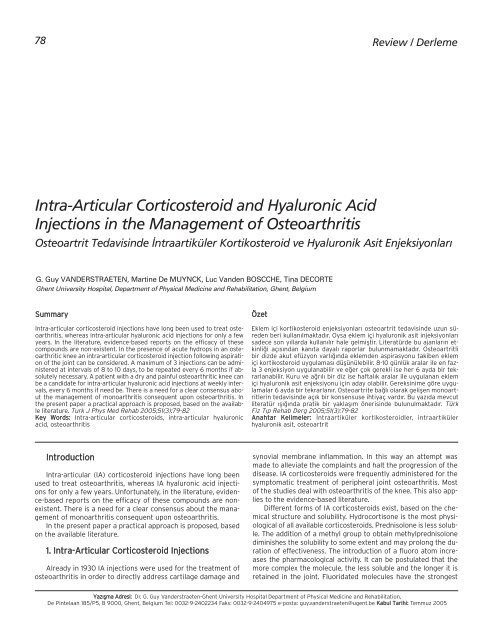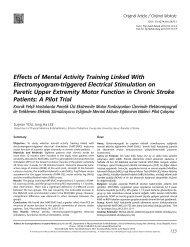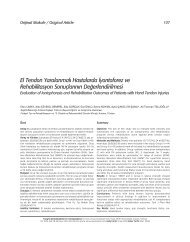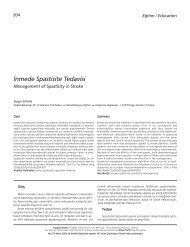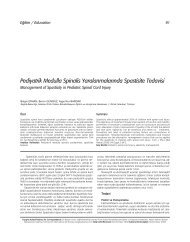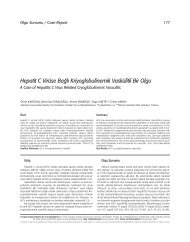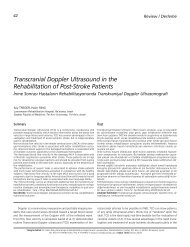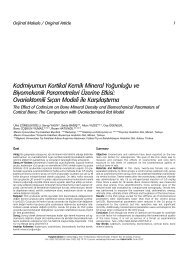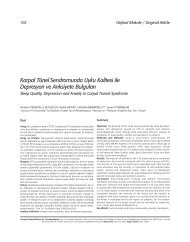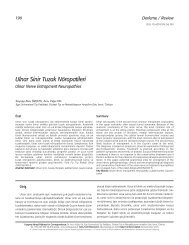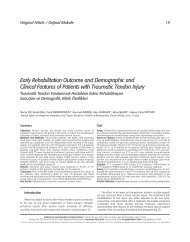Intra-Articular Corticosteroid and Hyaluronic Acid ... - FTR Dergisi
Intra-Articular Corticosteroid and Hyaluronic Acid ... - FTR Dergisi
Intra-Articular Corticosteroid and Hyaluronic Acid ... - FTR Dergisi
You also want an ePaper? Increase the reach of your titles
YUMPU automatically turns print PDFs into web optimized ePapers that Google loves.
78<br />
<strong>Intra</strong>-<strong>Articular</strong> <strong>Corticosteroid</strong> <strong>and</strong> <strong>Hyaluronic</strong> <strong>Acid</strong><br />
Injections in the Management of Osteoarthritis<br />
Summary<br />
<strong>Intra</strong>-articular corticosteroid injections have long been used to treat osteoarthritis,<br />
whereas intra-articular hyaluronic acid injections for only a few<br />
years. In the literature, evidence-based reports on the efficacy of these<br />
compounds are non-existent. In the presence of acute hydrops in an osteoarthritic<br />
knee an intra-articular corticosteroid injection following aspiration<br />
of the joint can be considered. A maximum of 3 injections can be administered<br />
at intervals of 8 to 10 days, to be repeated every 6 months if absolutely<br />
necessary. A patient with a dry <strong>and</strong> painful osteoarthritic knee can<br />
be a c<strong>and</strong>idate for intra-articular hyaluronic acid injections at weekly intervals,<br />
every 6 months if need be. There is a need for a clear consensus about<br />
the management of monoarthritis consequent upon osteoarthritis. In<br />
the present paper a practical approach is proposed, based on the available<br />
literature. Turk J Phys Med Rehab 2005;51(3):79-82<br />
Key Words: <strong>Intra</strong>-articular corticosteroids, intra-articular hyaluronic<br />
acid, osteoarthritis<br />
Introduction<br />
<strong>Intra</strong>-articular (IA) corticosteroid injections have long been<br />
used to treat osteoarthritis, whereas IA hyaluronic acid injections<br />
for only a few years. Unfortunately, in the literature, evidence-based<br />
reports on the efficacy of these compounds are nonexistent.<br />
There is a need for a clear consensus about the management<br />
of monoarthritis consequent upon osteoarthritis.<br />
In the present paper a practical approach is proposed, based<br />
on the available literature.<br />
1. <strong>Intra</strong>-<strong>Articular</strong> <strong>Corticosteroid</strong> Injections<br />
Already in 1930 IA injections were used for the treatment of<br />
osteoarthritis in order to directly address cartilage damage <strong>and</strong><br />
Özet<br />
Review / Derleme<br />
Osteoartrit Tedavisinde ‹ntraartiküler Kortikosteroid ve Hyaluronik Asit Enjeksiyonlar›<br />
G. Guy VANDERSTRAETEN, Martine De MUYNCK, Luc V<strong>and</strong>en BOSCCHE, Tina DECORTE<br />
Ghent University Hospital, Department of Physical Medicine <strong>and</strong> Rehabilitation, Ghent, Belgium<br />
Eklem içi kortikosteroid enjeksiyonlar› osteoartrit tedavisinde uzun süreden<br />
beri kullan›lmaktad›r. Oysa eklem içi hyaluronik asit injeksiyonlar›<br />
sadece son y›llarda kullan›l›r hale gelmifltir. Literatürde bu ajanlar›n etkinli¤i<br />
aç›s›ndan kan›ta dayal› raporlar bulunmamaktad›r. Osteoartritli<br />
bir dizde akut efüzyon varl›¤›nda eklemden aspirasyonu takiben eklem<br />
içi kortikosteroid uygulamas› düflünülebilir. 8-10 günlük aralar ile en fazla<br />
3 enjeksiyon uygulanabilir ve e¤er çok gerekli ise her 6 ayda bir tekrarlanabilir.<br />
Kuru ve a¤r›l› bir diz ise haftal›k aralar ile uygulanan eklem<br />
içi hyaluronik asit enjeksiyonu için aday olabilir. Gereksinime göre uygulamalar<br />
6 ayda bir tekrarlan›r. Osteoartrite ba¤l› olarak geliflen monoartritlerin<br />
tedavisinde aç›k bir konsensuse ihtiyaç vard›r. Bu yaz›da mevcut<br />
literatür ›fl›¤›nda pratik bir yaklafl›m önerisinde bulunulmaktad›r. Türk<br />
Fiz T›p Rehab Derg 2005;51(3):79-82<br />
Anahtar Kelimeler: ‹ntraartiküler kortikosteroidler, intraartiküler<br />
hyaluronik asit, osteoartrit<br />
synovial membrane inflammation. In this way an attempt was<br />
made to alleviate the complaints <strong>and</strong> halt the progression of the<br />
disease. IA corticosteroids were frequently administered for the<br />
symptomatic treatment of peripheral joint osteoarthritis. Most<br />
of the studies deal with osteoarthritis of the knee. This also applies<br />
to the evidence-based literature.<br />
Different forms of IA corticosteroids exist, based on the chemical<br />
structure <strong>and</strong> solubility. Hydrocortisone is the most physiological<br />
of all available corticosteroids. Prednisolone is less soluble.<br />
The addition of a methyl group to obtain methylprednisolone<br />
diminishes the solubility to some extent <strong>and</strong> may prolong the duration<br />
of effectiveness. The introduction of a fluoro atom increases<br />
the pharmacological activity. It can be postulated that the<br />
more complex the molecule, the less soluble <strong>and</strong> the longer it is<br />
retained in the joint. Fluoridated molecules have the strongest<br />
Yaz›flma Adresi: Dr. G. Guy V<strong>and</strong>erstraeten-Ghent University Hospital Department of Physical Medicine <strong>and</strong> Rehabilitation,<br />
De Pintelaan 185/P5, B 9000, Ghent, Belgium Tel: 0032-9-2402234 Faks: 0032-9-2404975 e-posta: guy.v<strong>and</strong>erstraeten@ugent.be Kabul Tarihi: Temmuz 2005
Türk Fiz T›p Rehab Derg 2005;51(3):79-82<br />
Turk J Phys Med Rehab 2005;51(3):79-82<br />
action (1). Nevertheless, IA corticosteroids do not remain in place<br />
for a long time. A systemic effect is also present. The depression<br />
of endogenous plasma cortisol after an IA corticosteroid injection<br />
may last three to four weeks (2). The anti-inflammatory action<br />
of each product in relation to an equivalent dose must also be<br />
taken into account. The anti-inflammatory effect of betamethasone<br />
<strong>and</strong> dexamethasone is 20 to 25 times greater than that of<br />
hydrocortisone. The most commonly available 1 ml vials contain<br />
an equivalent dose. The short-acting water-soluble forms are rapidly<br />
absorbed into the blood stream <strong>and</strong> consequently have more<br />
systemic effects. The long-acting crystalline depot preparations<br />
slowly release the corticosteroid <strong>and</strong> have less systemic effects.<br />
Mixed preparations also exist. The injected dose usually depends<br />
on the size of the joint. For the knee, ankle or shoulder joint<br />
1 ml vial is sufficient, for a medium-size joint (wrist) half of a<br />
vial, <strong>and</strong> for smaller a quarter of a vial is adequate.<br />
IA corticosteroids are administered to reduce local inflammation.<br />
The principal effect of glucocorticoids is the increased<br />
production of certain proteins, mainly lipocortin. Its anti-inflammatory<br />
action is based on the inhibition of phospholipase A2,<br />
which converts membrane phospholipids into arachidonic acid<br />
with a subsequent intracellular production of prostagl<strong>and</strong>ins, leukotrienes<br />
<strong>and</strong> oxygen radicals (3). Stimulation of lipocortin production<br />
inhibits the pro-inflammatory cytokine production, including<br />
interleukin-1, interleukin-2, interferon-α, tumor necrosis<br />
factor, etc. (4). Glucocorticoids inhibit the synthesis of pro-inflammatory<br />
enzymes, like collagenase, elastase <strong>and</strong> plasminogen<br />
activator (5).<br />
Indications <strong>and</strong> contra-indications<br />
IA corticosteroid injections are frequently used to treat a flare<br />
of osteoarthritis with hydrops, or posttraumatic synovitis. Other<br />
indications include early retractile capsulitis of the shoulder,<br />
rheumatoid arthritis, <strong>and</strong> even crystal monosynovitis, although<br />
corticosteroids are definitely not the first choice for this last<br />
condition.<br />
General contra-indications for IA corticosteroids are local or generalized<br />
infection, immune deficiency, coagulation disorders,<br />
prostheses <strong>and</strong> a pregnancy of less than 16 weeks. Relative contraindications<br />
are diabetes <strong>and</strong> a pregnancy of more than 16 weeks.<br />
Side effects<br />
IA corticosteroid injections may have a number of side effects,<br />
of which facial flushing is the most common (up to 40%).<br />
It is benign, self-limiting, <strong>and</strong> disappears within 24 to 48 hours,<br />
but the patient should be informed of its possible occurrence.<br />
Facial flushing also depends on which product is used <strong>and</strong> is more<br />
frequent with triamcinolone preparations. Van der Windt et al.<br />
compared the effectiveness of IA corticosteroid injections with<br />
physiotherapy for the treatment of frozen shoulder. With corticosteroids<br />
flushing occurred in 17% of cases, whereas in only 2%<br />
of cases treated with physiotherapy.<br />
After IA injections, mainly with hydrocortisone-acetate <strong>and</strong><br />
less with an acetonide ester or triamcinolone hexacetonide, chemical<br />
synovitis, mostly acute but self-limiting, develops in 2 to<br />
5% of cases. Pain <strong>and</strong> swelling may already occur after 6 hours<br />
<strong>and</strong> subside within 12 to 48 hours. Chemical synovitis or “postinjection<br />
flare” is a corticosteroid crystal-induced synovitis. Steroid<br />
arthropathy is a controversial subject, but the risk is low if the<br />
number of injections is small. An accelerated deterioration of<br />
weightbearing joints is, however, difficult to distinguish from the<br />
normal or natural course of osteoarthritis. Prevention is thus<br />
very important <strong>and</strong> repeated injections must be avoided. The<br />
st<strong>and</strong>ard is a maximum of two to three injections per year.<br />
Septic arthritis is rather uncommon thanks to sterile materi-<br />
V<strong>and</strong>erstraeten et al.<br />
<strong>Intra</strong>-<strong>Articular</strong> <strong>Corticosteroid</strong>s <strong>and</strong> <strong>Hyaluronic</strong> <strong>Acid</strong><br />
79<br />
al, meticulous skin disinfection <strong>and</strong> judicious use.<br />
A variety of systemic effects can occur. In the musculoskeletal<br />
system these include muscle weakness <strong>and</strong> atrophy, steroid<br />
myopathy, avascular necrosis, <strong>and</strong> osteoporosis. Gastrointestinal<br />
systemic effects are peptic ulcer, abdominal distension <strong>and</strong><br />
pancreatitis. Fluid <strong>and</strong> electrolyte disturbances have also been<br />
described <strong>and</strong> are characterized by sodium retention, potassium<br />
depletion, hypokalemic alkalosis <strong>and</strong> hypertension. Endocrinological<br />
systemic effects include irregular menses, Cushing syndrome,<br />
reactivation of latent diabetes, dysregulation of diabetes<br />
mellitus, <strong>and</strong> growth inhibition. Dermatologically, delayed wound<br />
healing, skin atrophy, petechiae <strong>and</strong> ecchymoses, striae, hirsutism,<br />
hyperpigmentation <strong>and</strong> acne are observed. The ophtalmological<br />
effects include glaucoma, exophtalmia <strong>and</strong> posterior subcapsular<br />
cataract. <strong>Corticosteroid</strong>s can also mask an infection or<br />
activate a latent infection <strong>and</strong> diminish the resistance to mycobacteria,<br />
C<strong>and</strong>ida albicans, tuberculosis <strong>and</strong> viruses.<br />
Evaluation of the literature data<br />
Papers on the use of IA corticosteroids for osteoarthritis are<br />
mainly confined to the knee. <strong>Corticosteroid</strong> injections for rheumatoid<br />
arthritis or juvenile rheumatoid arthritis, <strong>and</strong> facet joint<br />
injections are beyond the scope of this review.<br />
In a systematic review paper on IA corticosteroids for osteoarthritis<br />
of the knee, a minor advantage <strong>and</strong> pain reduction lasting<br />
from one week to one month, were found compared to placebo<br />
(6).<br />
In a r<strong>and</strong>omized clinical trial (7) 89 patients with osteoarthritis<br />
of the knee underwent joint aspiration followed by a steroid<br />
injection, with a beneficial effect on pain <strong>and</strong> functional index<br />
in the short term (four weeks).<br />
In a more recent meta-analysis (8) corticosteroids were found<br />
to have a positive effect on the symptoms for two weeks.<br />
The dose was equivalent to 6.25 to 80 mg prednisolone. The effect<br />
also remained positive in the long term. A significant<br />
symptomatic improvement was obtained after 16 to 24 weeks<br />
with a dose equivalent to 50 mg prednisolone.<br />
The authors mentioned a possible positive effect of publication<br />
bias.<br />
In two systematic review papers (9,10) the use of IA corticosteroid<br />
injections for shoulder pain was evaluated. Compared to<br />
placebo, no advantage with respect to pain reduction <strong>and</strong> improvement<br />
of the range of motion was found. In a r<strong>and</strong>omized clinical<br />
trial Snels (11) et al. treated 37 patients with three IA triamcinolone<br />
injections <strong>and</strong> compared the effects with placebo (saline<br />
solution). No significant difference in pain score or change in<br />
range of motion or function was observed.<br />
Studies (10) have also been conducted on the use of corticosteroids<br />
combined with lidocaine or not. In a systematic review<br />
paper no significant difference was demonstrated between IA<br />
corticosteroids combined with lidocaine <strong>and</strong> lidocaine alone in<br />
48 patients with frozen shoulder. The assessment of the results<br />
was based on the pain score <strong>and</strong> the range of motion. A r<strong>and</strong>omized<br />
study, in which corticosteroids (methylprednisone acetate)<br />
or placebo was injected intra-articularly following an arthroscopy<br />
for a synovial biopsy or for documenting the diagnosis of<br />
osteoarthritis, showed no clear differences in the Western Ontario<br />
Mc Master (WOMAC) score or Lequesne index at 8, 12 <strong>and</strong> 24<br />
weeks. After 4 weeks the IA corticosteroid scored better in the<br />
evaluation of the Osteoarthritis Research Society International<br />
(OARSI) criteria (12). The dose required to improve symptoms<br />
has also been studied (13). In a r<strong>and</strong>omized clinical trial of 57 patients<br />
with frozen shoulder, a comparison was made between 40<br />
mg <strong>and</strong> 10 mg triamcinolone. After six weeks markedly greater
80<br />
V<strong>and</strong>erstraeten et al.<br />
<strong>Intra</strong>-<strong>Articular</strong> <strong>Corticosteroid</strong>s <strong>and</strong> <strong>Hyaluronic</strong> <strong>Acid</strong><br />
relief was obtained with the higher dose, as measured by means<br />
of the VAS pain score, improvement in range of motion <strong>and</strong> functional<br />
improvement, but the difference disappeared after six<br />
months.<br />
High-quality studies on the use of IA corticosteroids for shoulder<br />
disorders are scarce. Moreover, the clinical outcome is correlated<br />
with the accuracy of the injection. Even in experienced<br />
h<strong>and</strong>s 10% of the injections would not have been given correctly.<br />
Consequently it has been suggested that the injections be<br />
administered under fluoroscopic or ultrasonographic guidance.<br />
The studies showed that diabetic patients who had received<br />
corticosteroids, required a higher dose of insulin or peroral antidiabetic<br />
drugs. The combination with non-steroidal anti-inflammatory<br />
drugs increased the risk of gastric bleeding. Barbiturates,<br />
phenylbutazone <strong>and</strong> phenytoin diminished the effectiveness<br />
of the corticosteroids.<br />
2. <strong>Intra</strong>-<strong>Articular</strong> <strong>Hyaluronic</strong> <strong>Acid</strong> Injections<br />
These so-called chondroprotective drugs, developed to inhibit<br />
cartilage degeneration, are controversial. Previously, glucosamine<br />
derivatives were used. More recently, IA hyaluronic acid<br />
has been introduced to treat osteoarthritis. <strong>Hyaluronic</strong> acid is a<br />
high-molecular weight polysaccharide <strong>and</strong> a major constituent<br />
of synovial fluid <strong>and</strong> cartilage.<br />
In osteoarthritis the molecular weight <strong>and</strong> concentration of<br />
hyaluronic acid are decreased. According to the concept of viscosupplementation<br />
IA hyaluronic acid would be beneficial in restoring<br />
the viscoelasticity of synovial fluid. It also has a number<br />
of biological actions. In preliminary studies on the use of IA hyaluronic<br />
acid injections, it was postulated that these would protect<br />
the articular surface <strong>and</strong> hence alleviate the pain <strong>and</strong> improve<br />
the range of motion. This would allow to reduce the use of<br />
non-steroidal anti-inflammatory drugs. Several products are<br />
available in Belgium. Largely, a distinction is made between lowmolecular<br />
weight <strong>and</strong> high-molecular weight hyaluronic acid.<br />
Most injections are given for knee osteoarthritis. In 1998 more<br />
than 10 million viscosupplementation injections were administered<br />
in the USA, with local reactions in only 3% of cases. During<br />
the same period 16,500 patients died of side effects of anti-inflammatory<br />
drugs for osteoarthritis. No anaphylactic or generalized<br />
side effects of IA hyaluronic acid injections have been reported.<br />
Adverse reactions have been reduced even more by the<br />
introduction of the new generation of biotechnologically produced<br />
hyaluronic acid products.<br />
The efficacy of hyaluronic acid is less as the cartilage becomes<br />
thinner. An acute infection must be treated first.<br />
The evidence-based literature mainly includes studies on knee<br />
osteoarthritis. Many contradictory data have been reported.<br />
A first state-of the-art review on the use of viscosupplementation<br />
in the last 2 decades, was published by Peyron (14) in<br />
1993. Pain relief was achieved, lasting from some weeks to as<br />
long as 6 months. A positive response was obtained in 65 to<br />
80% of cases. Compared to studies in which corticosteroids were<br />
used, the beneficial effect lasted significantly longer. Tolerance<br />
was generally very good. In 2003 a systematic review was<br />
published by Espallargues <strong>and</strong> Pons (15), who reported a predominantly<br />
short-term effect of a course of hyaluronic acid injections<br />
(Hylan-G-F 20) on the symptoms <strong>and</strong> knee function. Furthermore,<br />
hyaluronic acid delayed the need for knee replacement.<br />
Some trials have also shown long-term benefits. In a r<strong>and</strong>omized<br />
clinical trial (16) IA hyaluronic acid was compared with placebo<br />
<strong>and</strong> with oral naproxen. One injection was administered every fi-<br />
Türk Fiz T›p Rehab Derg 2005;51(3):79-82<br />
Turk J Phys Med Rehab 2005;51(3):79-82<br />
ve weeks. The follow-up at 26 weeks showed significant pain reduction<br />
during walking <strong>and</strong> at rest, compared to placebo. The<br />
improvement in the range of motion was at least as effective as<br />
after 26 weeks of continuous naproxen therapy, with less side effects.<br />
In a second r<strong>and</strong>omized clinical trial (17) hyaluronic acid<br />
was compared with placebo in 110 patients who received 1 injection<br />
every 5 weeks for 26 weeks. No significant difference in pain<br />
was observed. In a double-blind (18) r<strong>and</strong>omized multicenter<br />
study of patients with mild to moderate knee osteoarthritis, 5 IA<br />
hyaluronic acid injections were administered at one-week intervals<br />
<strong>and</strong> compared with placebo (saline solution). The WOMAC<br />
scale was used to assess the results. After 13 weeks a significant<br />
improvement was obtained in the hyaluronic acid group. In a<br />
multicenter double-blind study Wobig et al. (19) compared a saline<br />
solution with sodium hyaluronate. Three IA injections were<br />
administered once a week. The hyaluronic acid group had considerably<br />
less pain on weightbearing than the saline group until 24<br />
weeks after the last injection. Consequently, limited evidence<br />
exists that, compared to placebo, IA hyaluronic acid reduces the<br />
pain for periods from 1 month to 6 months. Except for some brief<br />
local discomfort postinjection, no major side effects have been<br />
reported. In a r<strong>and</strong>omized clinical study (20) methylprednisolone<br />
was compared with hyaluronic acid. One injection was administered<br />
at weekly intervals to 90 patients for five weeks. After<br />
60 days hyaluronic acid was found to be significantly superior<br />
to cortisone in relieving pain. Caborn et al. (21) conducted a<br />
r<strong>and</strong>omized, multicenter, single-blind study, running over a period<br />
of 26 weeks <strong>and</strong> comparing Hylan G-F 20 with triamcinolone<br />
hexacetonide in 215 patients with knee osteoarthritis. The WO-<br />
MAC, VAS <strong>and</strong> overall assessment scales were used to evaluate<br />
the outcome. Viscosupplementation resulted in a longer period<br />
of benefit than triamcinolone.<br />
A meta-analysis on hyaluronic acid again showed a small beneficial<br />
effect (22). Moreover, about 80% of the benefit appeared<br />
to be due to the placebo effect of an IA injection. The positive<br />
effect was even more overestimated because studies reporting<br />
positive results are more likely to be published than negative<br />
or nonsignificant results. Further trials are recommended to<br />
search for a subgroup that responds best to IA hyaluronic acid<br />
injections. Moderate evidence also exists that aspiration in itself<br />
is as effective as injections. In a single-center, prospective, open<br />
study (23) two to three IA hyaluronic acid injections were administered<br />
at weekly intervals to 20 patients with severe pain due<br />
to rhizarthrosis. The outcome assessment parameters were the<br />
VAS scale, grip strength, joint motion, crepitation during passive<br />
movement, <strong>and</strong> the global clinical impression of patients <strong>and</strong> investigator.<br />
It appeared that hyaluronic acid could be recommended<br />
for the treatment of rhizarthrosis because of its favourable<br />
effect on the above-mentioned parameters <strong>and</strong> the absence of<br />
adverse effects. In a very recent study of Petrella et al. (24), 537<br />
patients with knee osteoarthritis received 3 IA hyaluronic acid<br />
(500-730 kD) injections at weekly intervals. A second identical<br />
course was given if the patient so desired. The interval between<br />
the first <strong>and</strong> second course was 27±7 weeks. The duration of follow-up<br />
was 6 months. The outcome was assessed by means of<br />
the VAS scale at rest <strong>and</strong> on walking, <strong>and</strong> a 5-point global satisfaction<br />
score. This prospective study covered a period of 6.7 years.<br />
Both after the first <strong>and</strong> second course of injections a significant<br />
improvement was noted in the VAS <strong>and</strong> global satisfaction<br />
scores. The patients reported very few adverse effects <strong>and</strong><br />
required less concomitant therapies. This study showed some effect<br />
of IA hyaluronic acid in the long term.<br />
More <strong>and</strong> more data support a predominantly symptomatic
Türk Fiz T›p Rehab Derg 2005;51(3):79-82<br />
Turk J Phys Med Rehab 2005;51(3):79-82<br />
effect of IA hyaluronic acid, but a placebo effect cannot be ruled<br />
out. High-molecular weight products would be more effective<br />
(25). A chondroprotective effect has not been clearly demonstrated.<br />
Compared to st<strong>and</strong>ard corticosteroid injections, the cost<br />
is about 8 times higher <strong>and</strong> the efficacy is equal (26). Moderate<br />
evidence has been provided that IA hyaluronic acid actually<br />
works. Its long-term efficacy needs to be assessed, usually over<br />
a period of six months.<br />
A multicentre, r<strong>and</strong>omized, placebo-controlled, double-blind<br />
study in 335 patients with knee osteoarthritis was presented by<br />
Joergensen during the Eular 2005 Congress (27). <strong>Intra</strong>-articulair<br />
injections of 2 ml Hyalgan <strong>and</strong> 2 ml saline solution (placebo)<br />
were administered once a week for 5 weeks. The outcome was<br />
measured by the Lequesne algo-functional index, patients global<br />
assessment, pain during 5 m walk (100 mm VAS), Nottingham<br />
Health Profile Questionnaire, effusion <strong>and</strong> acetaminophen consumption.<br />
In patients with knee osteoarthritis five intra-articular<br />
injections of Hyalgan did not improve pain function or other outcome<br />
parameters 3, 6, 9 <strong>and</strong> 12 months after the treatment.<br />
Further examination is needed to look for subgroups that could<br />
really benefit from intra-articular hyaluronic acid.<br />
Besides the beneficial action on symptoms <strong>and</strong> function,<br />
hyaluronic acid may also have an effect on muscle strength. A 5week<br />
treatment with weekly hyaluronic acid injections resulted<br />
in a significant improvement of concentric <strong>and</strong> eccentric quadriceps<br />
muscle strength in patients with moderate knee osteoarthritis,<br />
suggesting a possible positive effect on the proprioceptive<br />
decline that may be present in osteoarthritis <strong>and</strong> give rise to<br />
muscle atrophy (28).<br />
Painful knee osteoarthritis, not responding to pharmacological<br />
or non-pharmacological treatments, with moderate radiographic<br />
changes, is the best clinical indication for IA hyaluronic<br />
acid injections. Other indications include more severe knee osteoarthritic<br />
changes in patients who refuse knee replacement. IA<br />
hyaluronic acid can also be used when anti-inflammatory drugs<br />
are contraindicated or not tolerated (29).<br />
Further studies are m<strong>and</strong>atory to establish the optimal dose,<br />
concentration <strong>and</strong> molecular weight of the product. More attention<br />
should also be paid to the economic advantages, because<br />
the favourable long-term effects reduce the need for anti-inflammatory<br />
drugs.<br />
Only minor side effects have been encountered (30). Mild pain<br />
or swelling at the injection site may occur in 20% of patients.<br />
Watterson <strong>and</strong> Esdaile (31) reported only a 3% incidence rate of<br />
local adverse reactions per injection, which resolved within 1 to<br />
2 days. Chen et al. (32) described six patients with granulomatous<br />
inflammation of the synovium following hyaluronic acid viscosupplementation<br />
of the knee. However, the responsible causative<br />
agent was not clearly demonstrated.<br />
Conclusion<br />
In the presence of acute hydrops in an osteoarthritic knee an<br />
IA corticosteroid injection following aspiration of the joint can be<br />
considered. A maximum of 3 injections can be administered at<br />
intervals of 8 to 10 days, to be repeated every 6 months if absolutely<br />
necessary. A patient with a dry <strong>and</strong> painful osteoarthritic<br />
knee can be a c<strong>and</strong>idate for IA hyaluronic acid injections at weekly<br />
intervals, every 6 months if need be (33).<br />
As for frozen shoulder, little evidence has been provided that<br />
IA corticosteroid injections would have a beneficial effect on pain<br />
<strong>and</strong> movement. The value of range-of-motion exercises has<br />
not yet been proven either. Spontaneous improvement in pain<br />
<strong>and</strong> limitation of movement might also occur.<br />
Compared to placebo, IA corticosteroids <strong>and</strong> hyaluronic acid<br />
have no serious disadvantages, but not many advantages either.<br />
References<br />
V<strong>and</strong>erstraeten et al.<br />
<strong>Intra</strong>-<strong>Articular</strong> <strong>Corticosteroid</strong>s <strong>and</strong> <strong>Hyaluronic</strong> <strong>Acid</strong><br />
81<br />
1. Bird HA. <strong>Intra</strong>-articular <strong>and</strong> intralesional therapy. Hochberg MC, Silman<br />
AJ, Smolen JS, Weinblatt ME, Weisman MH editors. Rheumatoloy.<br />
Edinburgh: Mosby; 2003. p. 393-7.<br />
2. Bird HA, Ring EF, Bacon PA. A thermographic <strong>and</strong> clinical comparison<br />
of three intra-articular steroid preparations in rheumatoid arthritis.<br />
Ann Rheum Dis 1979;38(1):36-9.<br />
3. Rothhut B, Russo-Marie F. Novel concepts in the mode of action of<br />
anti-inflammatory steroids. Agents Actions Suppl 1984;14:171-80.<br />
4. Grabstein K, Dower S, Gillis S, Urdal D, Larsen A. Expression of interleukin<br />
2, interferon-gamma, <strong>and</strong> the IL2 receptor by human peripheral<br />
blood lymphocytes. J Immunol 1986;136(12):4503-8.<br />
5. Werb Z. Biochemical actions of glucocorticoids on macrophages in<br />
culture. Specific inhibition of elastase, collagenase <strong>and</strong> plasminogen<br />
activator secretion <strong>and</strong> effects on other metabolic functions. J<br />
Exp Med 1978;147(6):1695-712.<br />
6. Kirwan JR, Rankin E. <strong>Intra</strong>-articular therapy in osteoarthritis. Baillieres<br />
Clin Rheumatol 1997;11(4):769-94.<br />
7. Ravaud P, Moulinier L, Giraudeau B, Ayral X, Guerin C, Noel E, et al.<br />
Effects of joint lavage <strong>and</strong> steroid injection in patients with osteoarthritis<br />
of the knee: results of a multicenter, r<strong>and</strong>omized, controlled<br />
trial. Arthritis Rheum 1999;42(3):475-82.<br />
8. Arroll B, Goodyear-Smith F. <strong>Corticosteroid</strong> injections for osteoarthritis<br />
of the knee: meta-analysis. BMJ 2004;328(7444):869.<br />
9. van der Windt DA, Koes BW, Deville W, Boeke AJ, de Jong BA, Bouter<br />
LM. Effectiveness of corticosteroid injections versus physiotherapy<br />
for treatment of painful stiff shoulder in primary care: r<strong>and</strong>omised<br />
trial. BMJ 1998;317(7168):1292-6.<br />
10. Green S, Buchbinder R, Glazier R, Forbes A. Interventions for shoulder<br />
pain. Cochrane Database Syst Rev 2000;(2):CD001156.<br />
11. Snels IA, Beckerman H, Twisk JW, Dekker JH, Peter De Koning, Koppe<br />
PA, et al. Effect of triamcinolone acetonide injections on hemiplegic<br />
shoulder pain: A r<strong>and</strong>omized clinical trial. Stroke<br />
2000;31(10):2396-401.<br />
12. Smith MD, Wetherall M, Darby T, Esterman A, Slavotinek J, Roberts-<br />
Thomson P, et al. A r<strong>and</strong>omized placebo-controlled trial of arthroscopic<br />
lavage versus lavage plus intra-articular corticosteroids in the<br />
management of symptomatic osteoarthritis of the knee. Rheumatology<br />
(Oxford) 2003;42(12):1477-85.<br />
13. De Jong BA, Dahmen R, Hogeweg JA, Marti RK. <strong>Intra</strong>-articular triamcinolone<br />
acetonide injection in patients with capsulitis of the<br />
shoulder: a comperative study of two dose regimens. Clin Rehabil<br />
1998;12(3):211-5.<br />
14. Peyron JG. <strong>Intra</strong>articular hyaluronan injections in the treatment of<br />
osteoarthritis: state-of-the-art review. J Rheumatol 1993;39:10-5.<br />
15. Espallargues M, Pons JM. Efficacy <strong>and</strong> safety of viscosupplementation<br />
with Hylan G-F20 for the treatment of knee osteoarthritis: a systematic<br />
review. Int J Technol Assess Health Care 2003;19(1):41-56.<br />
16. Altman R. <strong>Intra</strong>-articular sodium hyaluronate in osteoarthritis of the<br />
knee. Semin Arthritis Rheum 2000;30(2 Suppl 1):11-8.<br />
17. Dougados M, Nguyen M, Listrat V, Amor B. High molecular weight<br />
sodium hyaluronate (hyalectin) in osteoarthritis of the knee: a 1 year<br />
placebo-controlled trial. Osteoarthritis Cartilage 1993;1(2):97-103.<br />
18. Day R, Brooks P, Conaghan PG, Petersen M. Multicenter Trial Group.<br />
A double blind, r<strong>and</strong>omized, multicenter, parallel group study on the<br />
effectiveness <strong>and</strong> tolerance of intraarticular hyaluronan in osteoarthritis<br />
of the knee. J Rheumatol 2004;31(4):775-82.<br />
19. Wobig M, Dickhut A, Maier R, Vetter G. Viscosupplementation with<br />
hylan G-F20: a 26-week controlled trial of efficacy <strong>and</strong> safety in the<br />
osteoarthritic knee. Clin Ther 1998;20(3):410-20.<br />
20. Pietogr<strong>and</strong>e V, Turchetto L. <strong>Hyaluronic</strong>-acid versus methylprednisolone<br />
intra-articularly injected for the treatment of osteoarthritis of<br />
the knee. Curr Ther Res Clin Exp 1991;25:691-701.<br />
21. Caborn D, Rush J, Lanzer W, Parenti D, Murray C; Synvisc 902 Study<br />
Group. A r<strong>and</strong>omized, single-blind comparison of the efficacy <strong>and</strong> tolerability<br />
of hylan G-F 20 <strong>and</strong> triamcinolone hexacetonide in patients<br />
with osteoarthritis of the knee. J Rheumatol. 2004;31(2):333-43.<br />
22. Lo GH, LaValley M, McAlindon T, Felson DT. <strong>Intra</strong>-articular hyaluro-
82<br />
V<strong>and</strong>erstraeten et al.<br />
<strong>Intra</strong>-<strong>Articular</strong> <strong>Corticosteroid</strong>s <strong>and</strong> <strong>Hyaluronic</strong> <strong>Acid</strong><br />
nic acid in treatment of knee osteoarthritis: a meta-analysis. JAMA.<br />
2003;290(23):3115-21.<br />
23. Talke M. <strong>Intra</strong>articular hyaluronic acid in osteoarthritis of the carpometacarpal<br />
joint. Akt Rheumatol 2002;27:101-6.<br />
24. Petrella RJ. <strong>Hyaluronic</strong> acid for the treatment of knee osteoarthritis:<br />
long-term outcomes from a naturalistic primary care experience.<br />
Am J Phys Med Rehabil 2005;84(4):278-83.<br />
25. Wobig M, Bach G, Beks P, Dickhut A, Runzheimer J, Schwieger G, et<br />
al. The role of elastoviscosity in the efficacy of viscosupplementation<br />
for osteoarthritis of the knee: a comparison of hylan G-F20 <strong>and</strong><br />
a lower-molecular-weight hyaluronan. Clin Ther 1999;21(9):1549-62.<br />
26. Jones AC, Pattrick M, Doherty S, Doherty M. <strong>Intra</strong>-articular hyaluronic<br />
acid compared to intra-articular triamcinolone hexacetonide in inflammatory<br />
knee osteoarthritis. Osteoarthritis Cartilage 1995;3(4):269-73.<br />
27. Joergesen A, Stengaard–Pedersen K. Hyaluronan intra-articular is<br />
without clinical effect in knee osteoarthritis (OA). A multicentre,<br />
r<strong>and</strong>omized, placebo-controlled, double blind study. Ann Rheum Dis<br />
2005;64(111):66.<br />
Türk Fiz T›p Rehab Derg 2005;51(3):79-82<br />
Turk J Phys Med Rehab 2005;51(3):79-82<br />
28. Tang SF, Chen CP, Chen MJ, Hong WH, Yu TY, Ysai WC. Improvement<br />
of muscle strength in osteoarthritic knee patients after intraarticular<br />
knee injection of hyaluronan. Am J Phys Med Rehabil<br />
2005;84(4):274-7.<br />
29. Ayral X. Injections in the treatment of osteoarthritis. Best Pract Res<br />
Clin Rheumatol 2001;15(4):609-26.<br />
30. Waddell DD. The tolerability of viscosupplementation: low incidence<br />
<strong>and</strong> clinical management of local adverse events. Curr Med Res<br />
Opin 2003;19(7):575-80.<br />
31. Watterson JR, Esdaile JM. Viscosupplementation: therapeutic mechanisms<br />
<strong>and</strong> clinical potential in osteoarthritis of the knee. J Am<br />
Acad Orthop Surg 2000;8 (5):277-84.<br />
32. Chen AL, Desai P, Adler EM, Di Cesare PE. Granulomatous inflammation<br />
after Hylan G-F 20 viscosupplementation of the knee: a<br />
report of six cases. J Bone Joint Surg Am 2002:84A(7):1142-7.<br />
33. Uthman I, Raynauld JP, Haraoui B. <strong>Intra</strong>-articular therapy in osteoarthritis.<br />
Postgrad Med J 2003; 79(934):449-53.


